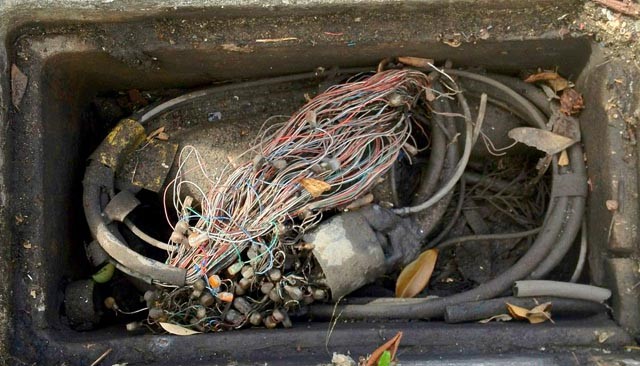NBN Rollout
I have been asked to write an article about the state of the NBN rollout in Rockhampton, trying to put some perspective on the situation as well as keeping the article in layman’s terms. This task should prove to be only a little harder than splitting an atom – so here we go! Firstly some background is needed since the general population seems to have been kept in the dark, because I don’t think even the politicians really know what they are debating.
All of the fuss centres on how we should transmit communication signals in this country – whether by copper wires or fibre optics. These signals carry not only our phone calls and faxes but also our emails, our access to the Internet and all other electronic data transferred between computers. Since the birth of the telephone by Alexander Graham Bell in 1876 these signals have been carried by copper wires.
Unfortunately copper is not a ‘perfect’ carrier of electronic signals and a certain degradation of the original signal occurs over distance as well as the physical deterioration of the copper cables themselves from various forms of corrosion. We have become smarter and combat this by coating the copper with insulation, by twisting ‘pairs’ of wires together which reduces the interference between them and by using repeater/booster apparatus to extend how far a signal can be reliably transmitted.
While the world found that using copper wires for communication was a technology that was ‘relatively’ easy to understand, easy to develop and easy to implement the development of fibre optic cables for communications has also been happening. In 1880 only 4 years after inventing the telephone Mr Bell also played around with a ‘photophone’ which used light to carry a voice signal.
Many others have since worked on using light to carry communication signals to the point that 1950 saw the first introduction of beaming light down a glass-clad tube (a fibre) to transmit information. In 1975 the United States Government used these glass-like fibres (fibre optic cables) to link together the computers at the NORAD centre & in 1988 the first transatlantic fibre optic communication cable was laid. My point here is that fibre optics for communications is NOT a new technology but one that did not get the head start of copper!
Fibre optic cables now have many attributes that place them head and shoulders in front of copper technologies. In comparison to copper, fibre optics can carry hundreds – even thousands of individual data streams down the one physical strand. The speed and capacity of fibre to carry communication signals is second to none and leaves copper for dead. Fibre doesn’t have the same signal degradation or loss of copper over a long distance. Fibre does not conduct electricity which keeps communication equipment and PEOPLE safe from electrical interference and lightning strikes & fibre cables don’t pick up environmental noise and don’t create interference when long strands are run besides each other.
So while fibre optic technologies were being developed Australia was busy burying thousands and thousands of miles of copper cables right to the very doorstep of nearly every Australian home. One problem with this – bury a piece of copper wire and piece of glass in the ground for 10 years and see what is left of them! You will be able to grab the piece of glass, give it a quick polish and it will still be perfect – just like it was when new, however it could prove challenging to even find the remains of the copper wire! Unfortunately this leads to another one of the main problems facing Australian communications right now – the degradation of our existing copper network and the associated maintenance costs. Copper cabling has an expiry date and a lot of Australia’s existing copper network is already way past that date.
There is absolutely zero debate as to whether fibre optic cable is better than copper – the whole world knows it is and fibre optic cabling is not new to Australia. All of our telecommunications backbones (the main cables linking states and cities) are fibre optic. Nearly all new housing estates built in the last 4 to 5 years were connected with fibre optic right from the start. Copper cabling is simply no longer used because of its shortcomings however the great debate (between political parties) is whether we replace all of our existing copper cables with fibre optic – right to the doorstep (fibre to the premise) “FTTP” or some half way measure like (fibre to the node) “FTTN”.
The National Broadband Network (NBN) scheme that Labour came up with had the charge of connecting around 93% of Australian homes and business directly with fibre optic cabling to their premises (FTTP). Our new government wants to trim (cut cut cut) this development back to running fibre optic cables only as far as a central ‘node’ and then interfacing this new fibre optic run with the old copper cables which would then carry signals the rest of the way to our doorsteps. This idea was already mooted by Telstra themselves back in 2005 and rejected by the ACCC as not a feasible model. This was almost a decade ago when the idea probably wasn’t too bad but look at what has changed since then.
I the last decade, technology has given us high definition pictures from a simple hand held camera phone, high definition movies, high speed Internet (in other countries), the possibility of remote connections and much larger (more comprehensive) file sizes for every kind of database from accounting packages to customer relationship management packages. Computers have become around 30 to 50 times more powerful and hard drives now hold up to 100 times as much data. Private citizens and business alike are trying to share this data and push it around the country on a copper based network which was never intended to service these requirements.
All sources are suggesting that fibre to the node will give us average download speeds of around 13Mbps (remember that even our existing 4G wireless network is capable of speeds around the 20Mbit mark) whereas fibre to the premise can deliver up to 400Mbps! Fibre to the premise would allow Australian business to link branch offices even in separate states as though they were in the same building. It would also allow home users to Skype with their loved ones with a video picture and sound quality as though they were in the same house. It would allow businesses to have simple off site backup systems and existing telephone systems would continue to just work. The other big plus is the extremely low cost of maintenance of fibre optic cables. The argument that we should wait for the next communication technology to be released is absurd – as there is nothing else on the drawing board. We have already seen that fibre optic has been around for several decades – we have just been too slow, or too broke or too stupid to properly adopt it.
Of particular interest to Rockhamptonites is the fact that parts of Rocky were reportedly about to get the NBN rollout. Under the current policy of our new government I now very much doubt that this will go ahead. It has always been NBN Co exaggerating the level of their progress – no doubt to justify their own jobs however on the other hand our previous opposition have tried to denigrate the state of the NBN rollout – because somehow this is supposed to make them look better? No doubt the actual truth lies somewhere between these two extremes. However, according to Malcolm Turnbull’s office there are “no constructions contracts that have been signed in Rockhampton”. This is certainly not news that is good for the growth of Rockhampton.
Our country desperately needs the NBN and it should be mandatory that we have Australian based companies and resources driving it forward. Unfortunately at present – what I believed was the one actual good policy that Labour had is being shot down because of the school boy attitude of having to pooh hoo EVERY policy the other party had simply because they were the other party. The Current government needs to wake up, smell the corroding copper, sense the need for a proper national communications network, show some backbone and do an about turn on their fibre to the node suggestion – it was dead in the water 10 years ago. A government that actually listens to the people and is big enough to admit when they are wrong is one that I would HAPPILY give my next vote to!
Future Byte Me topics can be emailed to [email protected] and Bruce is contactable at Kerr Solutions, 205 Musgrave Street or on 49 222 400.
For more advice and assistance from Kerr Solutions, like and follow us on Facebook

